
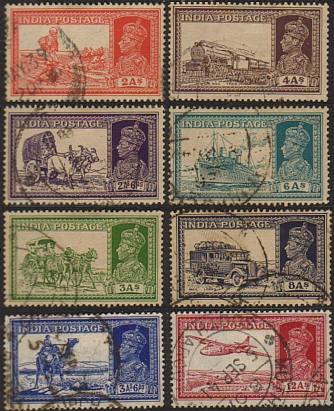
Here is a set of Indian stamps issued in 1937, when India was a British colony. They show various means of transporting mails in India at that period. As regular stamps, these designs were excellent and the stamps were typographed with decent quality.
The 2 annas stamp shows transportation by human's foot. Then you can find bullock cart, tongas, and camels. All of them are based on animal powers. Then for higher values, trains, steamers, trucks, and airplanes are designed. The arrangement of denominations seems to suggest a modernism view.
Among them, what transportation means are still in use today? Trains, ships, trucks, and airplanes: Yes. Bullock cart, tongas, and camels: they are fading away.
What about humans? Well they are still in high demand. Trucks can substitute animals if there are roads. Humans are still needed in several locations with very bad access. According to India Today (15 April 1994), there were about 200 mail runners employed by Indian post offices all over India. They were concentrated in remote areas of West Bengal, Bihar, Kerala, Sikkim, and Arnachal Pradesh. Even in the era of e-mails and EMS, the old-style way of communication is still functioning in India.

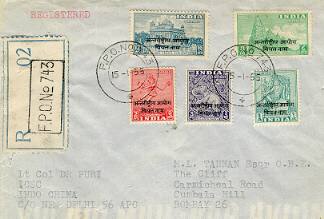 In Japan, sending the self defence army to peace-keeping activities of the UN is politically a sensitive matter. India is far ahead us. Everywhere the UN military is operating, you can find Indian armies. And... everywhere the Indian army is operating under the UN banner, there are Indian post offices!
In Japan, sending the self defence army to peace-keeping activities of the UN is politically a sensitive matter. India is far ahead us. Everywhere the UN military is operating, you can find Indian armies. And... everywhere the Indian army is operating under the UN banner, there are Indian post offices!
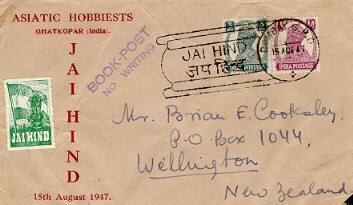 In India, instead, special cancellations were used. "Jai Hind" is a slogan raised by the patriot Chandre Bose. The cover shown here was cancelled on 15 August 1947, i.e., the independence day, in Bombay.
In India, instead, special cancellations were used. "Jai Hind" is a slogan raised by the patriot Chandre Bose. The cover shown here was cancelled on 15 August 1947, i.e., the independence day, in Bombay.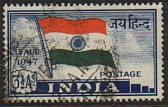
Indian people had to wait until 21 November 1947 for new stamps of independent India. The first issue includes the one shown here, depicting Indian national flag. However, the supply of new stamps were not enough. British Indian stamps depicting King George VI were used throughout independent India until 1957, when the currency was changed into a decimal system. In some sense, it was not annoying for India because the Republic of India inherits everything modern from the British Raj.
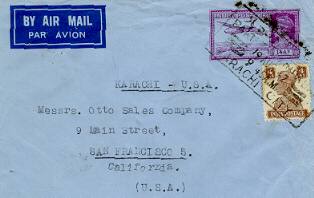 In Pakistan, as in India, special cancellations were used throughout the country to celebrate independence. "Pakistan Zindabad" is a slogan shown in the cancellation. The cover shown here was cancelled on 19 August 1947 in Karachi.
In Pakistan, as in India, special cancellations were used throughout the country to celebrate independence. "Pakistan Zindabad" is a slogan shown in the cancellation. The cover shown here was cancelled on 19 August 1947 in Karachi.
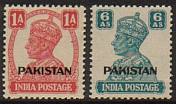
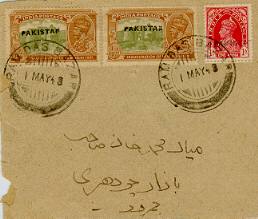 Unlike in India, however, for Pakistan's policy makers, it was very annoying to use British Indian stamps because they show "INDIA" as the name of the country. They wanted new stamps inscribed "PAKISTAN" as soon as possible. Since there were no such printing facilities in Pakistan, a stock of British Indian stamps were sent to India and India's Printing Authority at Nasik overprinted "PAKISTAN" on these stamps (see the photos on the left). They were issued on 1 October 1947 and British Indian stamps without overprints became invalid soon.
Unlike in India, however, for Pakistan's policy makers, it was very annoying to use British Indian stamps because they show "INDIA" as the name of the country. They wanted new stamps inscribed "PAKISTAN" as soon as possible. Since there were no such printing facilities in Pakistan, a stock of British Indian stamps were sent to India and India's Printing Authority at Nasik overprinted "PAKISTAN" on these stamps (see the photos on the left). They were issued on 1 October 1947 and British Indian stamps without overprints became invalid soon.
This created an acute scarcity of stamps in several post offices. As an emergency measure, several post masters were allowed to overprint locally. The cover (shown right) is an example of local overprints used in NWFP. Pakistani people had to wait until July 1948 to have a set of new stamps printed for Pakistan.

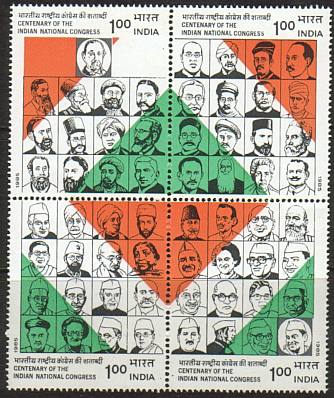 Everywhere in the world, politicians are searching for medias to advertise them. Postage stamps are attractive medias. However, the value of politicians is difficult to judge when they are alive. Most of postal authorities therefore have a policy not to use current politicians as motives.
Everywhere in the world, politicians are searching for medias to advertise them. Postage stamps are attractive medias. However, the value of politicians is difficult to judge when they are alive. Most of postal authorities therefore have a policy not to use current politicians as motives.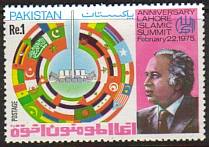
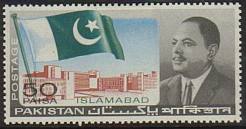 In sharp contrast, current presidents or prime ministers are favorite motives on Pakistani stamps. President Ayub Khan is shown in the 1966 stamp of Islamabad construction. Prime Minister Zulfikar Ali Bhutto is found in the 1975 stamp of Islamic Summit. His daughter, Ms. Benazir Bhutto, also appeared in the 1995 stamps commemorating the 4th World Conference on Women at Beijing, when she was the Prime Minister of Pakistan.
In sharp contrast, current presidents or prime ministers are favorite motives on Pakistani stamps. President Ayub Khan is shown in the 1966 stamp of Islamabad construction. Prime Minister Zulfikar Ali Bhutto is found in the 1975 stamp of Islamic Summit. His daughter, Ms. Benazir Bhutto, also appeared in the 1995 stamps commemorating the 4th World Conference on Women at Beijing, when she was the Prime Minister of Pakistan.
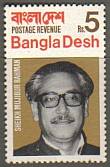 In Bangladesh as well, the first stamps of Bangladesh included the portrait of Mr. Mujibur Rahman (the photo on the left). The portrait of President Ershad can be found on the 1987 issue to publicize the restoration of democracy.
In Bangladesh as well, the first stamps of Bangladesh included the portrait of Mr. Mujibur Rahman (the photo on the left). The portrait of President Ershad can be found on the 1987 issue to publicize the restoration of democracy.
All these names in Pakistan and Bangladesh have one thing in common. Theses politicians were not able to complete their career safely. Thrown away by military coup, assassinated, etc. It seems advisable for politicians not to use their portraits on stamps.
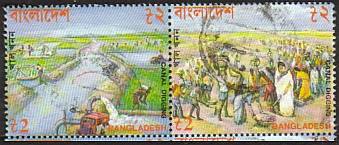 ...then I found this stamp of Bangladesh issued in 1993. The woman in white saree who initiated the construction of irrigation canals seems to be Prime Minister Khaleda Zia. Hope the jinx does not work against her.
...then I found this stamp of Bangladesh issued in 1993. The woman in white saree who initiated the construction of irrigation canals seems to be Prime Minister Khaleda Zia. Hope the jinx does not work against her.